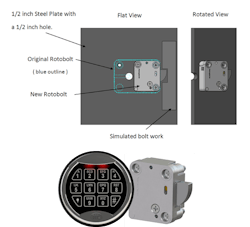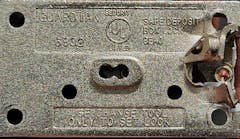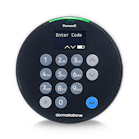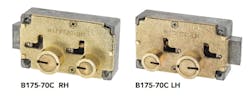There has been a revolution in the safe industry over the last couple of decades as mechanical safe locks have given way to the more efficient and convenient electronic locks. Like mechanical door locks, mechanical safe lock technology will remain a locksmith staple for many applications and price ranges, but as faster and cheaper communication platforms evolve, the electronic locks will continue their migration into the marketplace.
“These are very exciting times for the safe lock world. Electronic locks are becoming more and more popular mainly because they are much easier and faster to use when compared to mechanical locks. The biggest disadvantage, of course, is the need to supply power to electronic locks. Most lock manufacturers, do however, provide a dedicated battery compartment inside the keypad,” says Susan Papa, who has been the CEO of LpLOCKS in Orange County, California for more than 12 years and is the former VP of Sales and Marketing at LaGard for 23 years.
Electronic safe locks relieve the user the burden of having to memorize numbered combination and often complicated dialing instructions that required safe vendors to supply step-by-step opening instructions. With today’s technology, the user has multiple options that include electronic numeric keypads, along with wireless options like WiFi and Bluetooth.
Communications is the Key to the New Locks
Travis Ferry, Senior Electrical Engineer at Sargent and Greenleaf, explains that the speed and security of various communication methods (such as Bluetooth and WiFi) have greatly improved and this increased speed of the communication allows the products to include much stronger encryption routines without any noticeable delays to the end users.
“Stronger encryption requires much more communication, but the faster speeds have made this much more streamlined. In addition, the security aspect of communication continues to grow every day. Bluetooth and WiFi companies continue to implement stronger and safer encryption routines into their products, which makes them increasingly more difficult to compromise,” says Sargent and Greenleaf’s Ferry.
Papa also adds that electronic locks with the solenoid blocking feature were very popular for many years; yet today none of the reputable, quality, high security, lock manufacturers use solenoids because of the related and very relevant security issues: solenoids can easily be tampered with by shocks, vibrations or large magnets. She says that any serious safe maker or safe technician today should avoid the use of a solenoid blocking device on a safe door, regardless of the safe’s rating.
According to Papa, NL Lock was the first manufacturer to release a high-quality motor blocking feature into electronic high security locks to replace solenoids. NL Lock is also the first manufacturer, and thus far the only one, to introduce a patented reduced size high-security lock which represents a great innovation in terms of safe protection and cost reductions.
NL Lock was also the first with the development of a Redundant Lock with a Type 1 and Group 2M UL Listing. The Redundant RotoBolt with Dual Basic Keypad is the answer to using a high security electronic lock on a TL-15 / TL-30 safe. Additionally, it addresses concerns of safe owners about losing power and not having immediate access to their property.
When it comes to some of the key aspects of mechanical to electronic safe lock retrofits the average locksmith needs to know and what applications and vertical markets have driven this safe retrofit environment. Ferry says that when converting mechanical locks to electronic locks, the general “footprint” of the lock and the keypad is almost always the same.
“This makes for a very quick and easy retrofit process. In addition, almost all electronic locks allow end users to create multiple users that can access the container. With mechanical solutions, there is typically only one key or one combination that can be used to open a mechanical lock. This means that multiple users of a lock must share the same key or code. With electronic locks, users can create separate users for all those who require access to the container, without sharing the same code,” explains Ferry.
He adds that the two biggest advantages for moving to electronic locks are convenience and security.
“Many mechanical solutions take significant time to open or you might have to carry around specific keys to open them. Electronic locks can always be quickly accessed through the keypad or your mobile device,” stresses Ferry. “In addition, electronic locks provide extra layers of security to the container. Electronic locks can allow for multiple users to be setup (instead of sharing a key) and many electronic locks include auditing functions that can tell you who accessed the safe and when they accessed it.”
Locksmiths Help Clients Stay Ahead of the Curve
The way Chris Strauss, the owner of Grand Valley Lock Shop in Malvern, Penn., sees it, the ever-changing world of technological advances can work to the advantage or disadvantage of today’s locksmith, and this is certainly true when it comes to modern features and security safes.
“Seeing people break into safes on the big screen or in television shows is nothing new. However, this practice used to involve a stick of dynamite or a stethoscope to gain access to the safe, but today just about anyone with YouTube access can learn how to break into a radial dial combination lock. This brings forth the question of whether one should invest in electronic safe locks or stick with a dial lock,” ponders Strauss.
When dealing with potential safe buyers in his shop, Strauss explains that traditionally, an electronically locking safe is more expensive than dial combination locks. He asks his customers to assess their risk situation and determine if the investment is worthwhile, which is going to depend on the value of what they are trying to protect.
“If you don’t feel as though your safe is at risk of being broken into or you only keep paperwork in there, a dial lock may be adequate,” he tells clients. “However, if you plan to stash your cash, jewelry or priceless information in your safe, you could put yourself at a disadvantage by skimping on your safe purchase.
“Beyond the cost factor and the fact that you may need to change a battery every so often, there really aren’t any other reasons to not to consider investing in a modern safe with electronic locking features. In fact, their capabilities far outshine the slight cost increase.”
According to Strauss, going with the high-tech option of buying an electronic safe has quite a few perks. Between the ease of operation, their reliability and stellar security features, there is much to be said for the benefits of electronic safe installations. He lists the following benefits as characteristics of today’s electronic safe locks:
1. Ease of Operation: If you want to avoid the hassles of trying to use a dial combination in the dark, an electronic keypad can provide an ideal solution. Typically, the keypad lights up and beeps as you use it, meaning if you are trying to quickly access you safe for protective weapons or for your cash to make a quick exit in a crisis, you can get the goods fast any time of day or night. Another convenience is that you can change the combination on these safes easily, and 75 percent of all lockout situations can be resolved without drilling and ruining your device.
2. Reliability: While old dial lock safes are reliable, there is quite a bit of additional reliability with newer electronic keypad safes. You can pre-program the master codes and super master reset codes for extra reliability and convenience. These models can even be set for multiple users with different codes that allow you to add users, delete users, enable and disable functions and even audit who has opened your safe and when they did so. If you own a business, this is clearly an asset.
3. Safety and Security: When it comes to additional safety features, electronic locks reign the industry. You can set several useful secondary security checks that increase the reliability and safety of your safe with modern features that include:
- Dual Controls: This feature requires two separate combination entries in order to function.
- Dual Token Mode: Want the extra security of needing a code and a key for entry? This feature of electronic locks doubles your protection.
- Time Delay Options: You can set your safe to only open after a short delay period. This can be frustrating to would-be thieves who are in a rush to make a quick exit after a burglary attempt.
- Duress Mode: If you are ever being held up and someone is trying to force your hand at opening the safe, there are options that include the ability to trigger a silent alarm that notifies the authorities of your duress.
- Time Period Window Settings: Do you only want your safe to be operable during certain hours, such as when your business is open? This feature makes that desire possible.
- Wrong Try Functions: Your safe will automatically disable itself after a specified amount of wrong code entries, which is sure to frustrate and discourage criminals.
- One-Time Use Codes: If you want to limit access to your safe to another individual on a temporary or one time use basis, you can set a UTC code that makes it possible.
“One final point to consider is that combination locks have not evolved over time, while electronic safe keypad locks have. Penetrating these safes has become more challenging day by day, so if you really want maximum security going with an electronic safe is the best choice,” concludes Strauss.
Safes and the Internet
Susan Papa figures that the internet and mobile applications are the next big thing in electronic safe technology. She says that more and more frequently, new products are released with the capability to get an online connection through a Bluetooth or Wi-Fi module. The tech world calls this the Internet of Things (IoT) and all market research firms expect it to become a very large market. These new capabilities are going to grow the industry, but locks and safes are the one place where you can’t take any chances, so you must look at new technologies very carefully and build the right skills and relationships. Only experienced and skilled lock manufacturers should be trusted when it comes to lock integration with such technologies and the real benefits of such integration should be carefully evaluated.
“Once you have a solid solution, the selling points are really exciting. They come in two parts. Part 1 is controlling access; a) remote control of your safe from far away or on site, b) the ability to allow someone else to open the safe one time or for an allotted period and c) the ability to transfer control to someone else temporarily or permanently, if needed. Part 2 is monitoring the safe and looking at the information about its usage. For example, it can notify you if there is an attempt to open, it can tell you who accessed the safe and when,” explains Papa
Papa says her team is very excited about internet-connected safe locks. She realizes that just like electronic locks, there are new capabilities, but also new ways things can go wrong. Being able to ask what-if questions of the lock industry when examining the many new technology factors is crucial. Below are a few examples of the “what-if” questions her team has posed to help locksmiths understand the issues:
- How exactly does the safe connect to the network? What hardware options are there? How do they stack up now and in the future?
- What is the customer’s unboxing experience like? How fast and reliable is it to connect the safe to the internet and make your phone app communicate with it?
- What happens if your WiFi is unavailable, how does the user’s mobile app control the safe?
- How long does it take from the time you click lock until you hear it lock?
- Can the back-end system handle it if hundreds or thousands of safes click open at the exact same time?
- How is the information that comes out of the safe structured, and where does it get managed?
- How do you protect all the data paths?
- If a hacker sets their mind to it, how tough would it be for them to hack into your specific safe?
Advanced Electronic Safe Lock Technology
LpLOCKS’ advanced inventory includes the NL Lock brand that combines electronics with the evolving world of IoT (Internet of Things) to safe locks. First One was developed in collaboration with Afero and Cannon Safe Company to approach the private safe industry with a complete solution for controlling and managing home safes through a smartphone and the web. The hardware-based security approach being utilized and supported by Afero, is industry leading, providing far more robust security for NL Lock customers versus alternatives in the market, says Papa.
The second, LockONE™ system, was developed in collaboration with NL Locks’ European partners to provide an up-to-date solution to manage and control CIT operated safe for bank customers, chain accounts or other corporations. LockONE™ features multiple users, time-based features, audit, as well as integrated rolling codes and encryption algorithms to allow one-time valid opening codes to be generated and managed through Web-based control software.
Sargent and Greenleaf is also offering advanced solutions in their new AxisBlu safe lock that combines the latest Bluetooth technology upgrades with the proven S&G Titan locks body to create a new option for safe security, which is the ability to access a safe via a mobile app.
New functionality and multiple layers of authentication in mobile devices make AxisBlu’s Bluetooth connectivity a reliable, fully secure method of access. AxisBlu is also the first secure safe lock with a no keypad option. Users may choose from a sleek, modern medallion or our tried-and-true traditional gun safe lock keypad.
“Our two newest products involve the incorporation of Bluetooth Low Energy (BLE) and Wireless networks (WiFi) into our communication schemes. The AxisBlu product line is a Bluetooth-enabled lock that incorporates the latest Bluetooth Low Energy technology. This allows for much stronger security routines than previous Bluetooth locks in the market. The ‘low energy’ component also provides longer battery life options over previous locks in this class,” adds Ferry. “The Nexus product line is a WiFi-enabled lock that works using an existing wireless connection. Just-launched NexusIP does not require any physical network connection and can be setup to use the same encryption routines as your current wireless router. Setup is very simple and can be performed quickly using our software and a flash drive.”
S&G also has a portfolio of Digital Platform safe locks that provides users a smarter, faster, and more secure way to respond to safe security needs by leveraging USB technology, providing greater storage capacity and a more robust method for securely transferring audit data. S&G offers a suite of products on the Digital Platform – Audit 2.0, A-Series with Display, Digital Time Lock, and NexusIP.
Hollon Safe Introduces TL-30 Series Gun Safes
In an effort to continually strive to bring new products to the market to meet customer requests of customers, Hollon Safe introduces the affordable “MJ” series of TL-30 safes.
Hollon’s “PM” series of TL-15 safes was very close to being a TL-30 when UL tested it. Now Hollon Safe presents its new TL-30 series. These models also pass our 2 hour fire test with flying colors.
“Due to the huge success of our TL-15, safe line we thought it was time to take it to the next level with affordable TL-30 safe series,” Zack Gilmore said when we asked about the introduction of the “MJ” series.
Hollon Safe Co. is a family owned business that has been one of the fastest-growing manufacturers of high security safes in the nation. For more information about the TL-30 and other Hollon products – including our 5 lines of gun safes – call (888) 455-2337, or visit www.HollonSafe.com.






